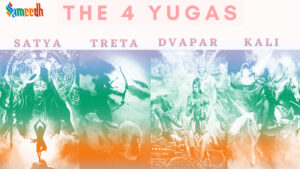In Hindu cosmology, the concept of the Yugs (ages or epochs) describes a cyclical progression of time, reflecting the changing nature of morality and spirituality over the course of cosmic cycles. The Yugs are divided into four main epochs, each with its own characteristics and duration.

ORIGIN
Yuga is derived from the Sanskrit word Yuj, meaning to join. Yug means the age, or age of the world or human life. Yug is essentially the cycle of life in Hinduism, it consists of four epochs of a series of formation and destruction. With each of these Yugs, not only does the lifespan of humans decrease by one fourth, the overall morals of the world take a dip as well. The Yugs are also associated with truth indicating how with very passing one, we get only one fourth of the previous cycle’s truth. It is essentially a cycle of 43,20,000 years and 12000 divine years. The four Yugs each being divided as, Satya or Krita Yug – 4,800 divine years, Treta Yug – 3,600 divine years, Dwapar Yug and Kali Yug for 2,400 and 1,200 years respectively It is believed that we are currently living in the Kali Yug where dishonesty and malice presides with a 3:1 ratio with honesty.
SIGNIFICANCE
The Yugs are well defined cycles of the world, they fall into a pattern of stabilising dharm, failing to do so, upon which an avatar of Vishnu takes birth and brings a balance. The Hindu god of preservation, pledged to take a reincarnation or birth in every Yug. He aimed to do this in order to maintain an equilibrium of righteousness in the world, to preserve the good and destroy the evil.
A symbolism of these cycles has been represented by the bull of dharm or code of conduct. In the first Yug, it stands on all four legs, in the second it only stands on three legs and so on. This depicts the instability of morals and rules.
The four Yugs, listed in order of decreasing righteousness, are:

Satya or Krita Yug is known as the golden Yug. This is also deemed to be the purest of the Yug with the maximum content of truth. The humans in this Yug were directly ruled over by the supreme forces. Events of a superior nature occurred during this period too, like the wedding of lord Shiv and Sati. This first cycle was the ideal scenario of life with perfect manifestations of energy. People were able to connect directly with the divine forces as their lives revolved around practises of meditation, knowledge acquisition and attainment of peace.
Treta Yug means three, as it is indicative of the virtues of the world have been reduced to three quarters. This was the cycle when kings wanted to rule the world, the thirst for power and supremacy began to take form. Wars over power and greed started taking place. Reincarnations of Vishnu such as Vamana, Ram and Parshuram lived in this Yug.
Dwapar Yug means two, as there are only two quarters of virtue and truth left for this epoch. The great Indian epic of Mahabharat took place in this Yug. It was a war in a family which forced blood relatives to kill each other, resulting in the decline of an entire dynasty. The class divide too emerged during this era.
Kali Yug is believed to be the last cycle, the one dominated by three quarters of dishonesty, spite and sin. This is when people surrender to their desires, the quest for knowledge is lost on people, darkness and ignorance prevails across lands. It has also been rightly predicted that the environment will be contaminated, there would be a shortage of resources. People will migrate from their own lands to live somewhere safe. Greed, lust, violence, manipulation will increase and pollute people’s minds. The Kalki avatar of lord Vishnu will appear in this Yug to put an end to one entire cycle of life.